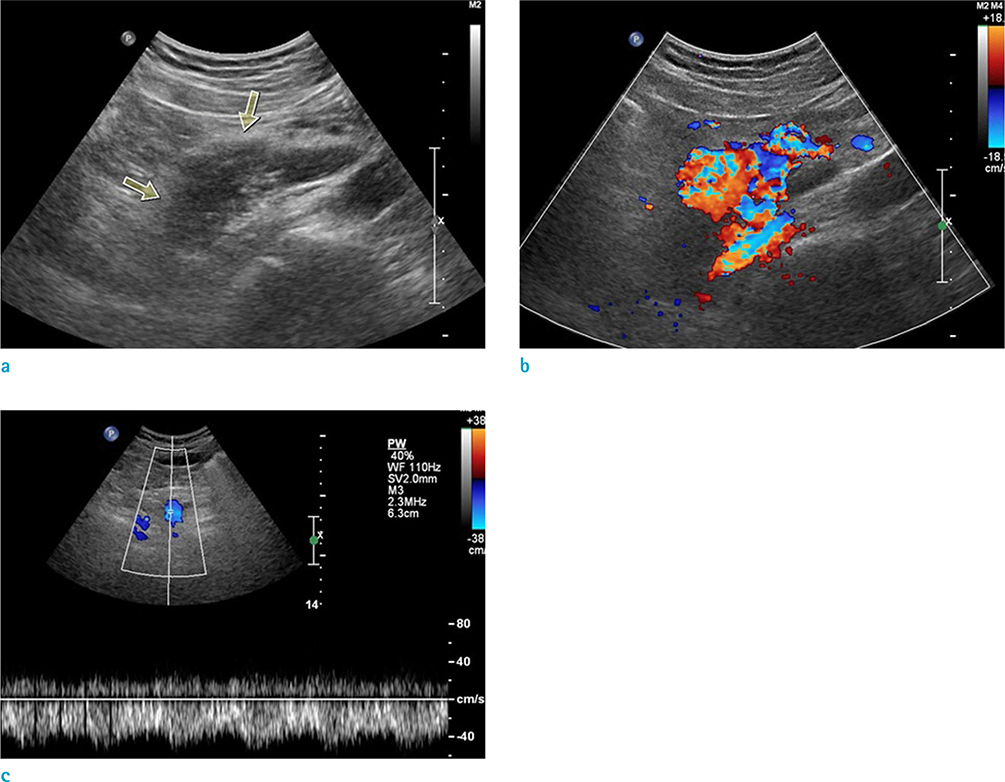Investig Magn Reson Imaging.
2015 Dec;19(4):241-247. 10.13104/imri.2015.19.4.241.
Pancreatic Arteriovenous Malformation as an Unusual Cause of Chronic Gastrointestinal Bleeding in a Patient with Early Gastric Cancer: Multimodality Imaging Spectrum with Pathologic Correlation
- Affiliations
-
- 1Department of Radiology, Chungnam National University Hospital, Chungnam National University School of Medicine, Daejeon, Korea. leeje290@gmail.com
- 2Department of Surgery, Chungnam National University Hospital, Chungnam National University School of Medicine, Daejeon, Korea.
- 3Department of Pathology, Chungnam National University Hospital, Chungnam National University School of Medicine, Daejeon, Korea.
- KMID: 2151772
- DOI: http://doi.org/10.13104/imri.2015.19.4.241
Abstract
- Arteriovenous malformation (AVM) of the pancreas is extremely rare, although it may be increasingly diagnosed due to the widespread use of cross-sectional imaging of the abdomen. Early diagnosis of this disease is important to prevent delay of treatment and resulting fatal complications. We report a rare case of pancreatic AVM in a 48-year-old man who presented with severe chronic anemia and early gastric cancer, which made diagnosis challenging. Imaging findings, including ultrasound, computed tomography, and magnetic resonance imaging, are shown, as well as the pathologic features.
Keyword
MeSH Terms
Figure
Reference
-
1. Rockey DC. Occult gastrointestinal bleeding. N Engl J Med. 1999; 341:38–46.2. Hansen W, Maximin S, Shriki JE, Bhargava P. Multimodality imaging of pancreatic arteriovenous malformation. Curr Probl Diagn Radiol. 2015; 44:105–109.3. Nishiyama R, Kawanishi Y, Mitsuhashi H, et al. Management of pancreatic arteriovenous malformation. J Hepatobiliary Pancreat Surg. 2000; 7:438–442.4. Meyer CT, Troncale FJ, Galloway S, Sheahan DG. Arteriovenous malformations of the bowel: an analysis of 22 cases and a review of the literature. Medicine (Baltimore). 1981; 60:36–48.5. Aida K, Nakamura H, Kihara Y, Abe S, Okamoto K, Otsuki M. Duodenal ulcer and pancreatitis associated with pancreatic arteriovenous malformation. Eur J Gastroenterol Hepatol. 2002; 14:551–554.6. Koito K, Namieno T, Nagakawa T, et al. Congenital arteriovenous malformation of the pancreas: its diagnostic features on images. Pancreas. 2001; 22:267–273.7. Makhoul F, Kaur P, Johnston TD, Jeon H, Gedaly R, Ranjan D. Arteriovenous malformation of the pancreas: a case report and review of literature. Int J Angiol. 2008; 17:211–213.8. Yoon JH, Han SS, Cha SS, Lee SJ. Color Doppler ultrasonography of a pancreatic arteriovenous malformation. J Ultrasound Med. 2005; 24:113–117.9. Walter JF, Chuang VP, Bookstein JJ, Reuter SR, Cho KJ, Pulmano CM. Angiography of massive hemorrhage secondary to pancreatic diseases. Radiology. 1977; 124:337–342.10. Chang S, Lim HK, Lee WJ, Choi D, Jang KT. Arteriovenous malformation of the pancreas in a patient with gastrointestinal bleeding: helical CT findings. Abdom Imaging. 2004; 29:259–262.
- Full Text Links
- Actions
-
Cited
- CITED
-
- Close
- Share
- Similar articles
-
- A Case of Pancreatic Arteriovenous Malformation with Portal Hypertension: Treatment with Transjugular Intrahepatic Portosystemic Shunt
- A Case of Arteriovenous Malformation of the Pancreas
- A Case of Duodenal Ulcer Bleeding caused by Pancreatic Arteriovenous Malformation
- A Case of a Spontaneous Hemoperitoneum as the Presentation of a Gastric Arteriovenous Malformation
- A case of hemosuccus pancreaticus in arteriovenous malformation





